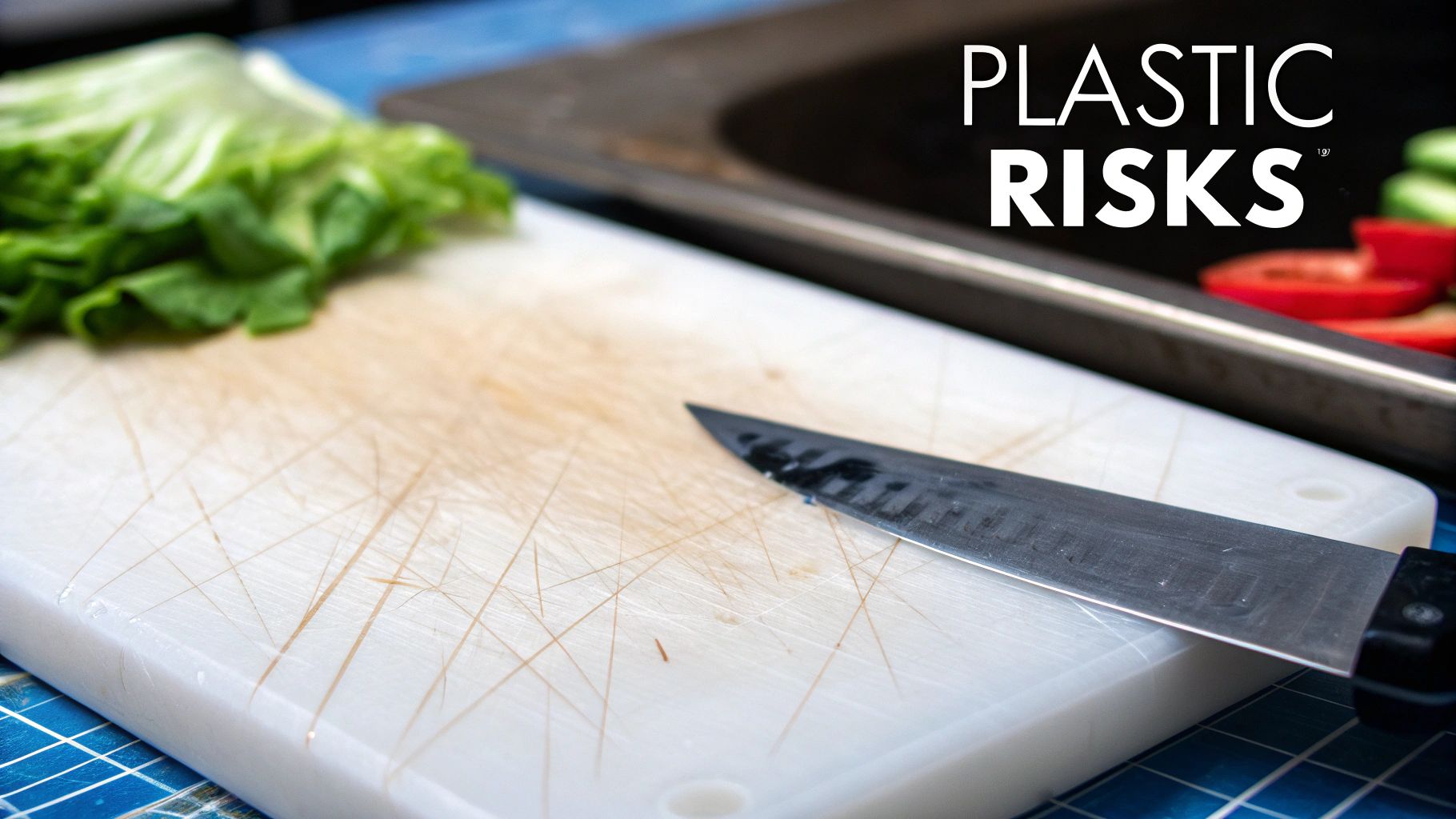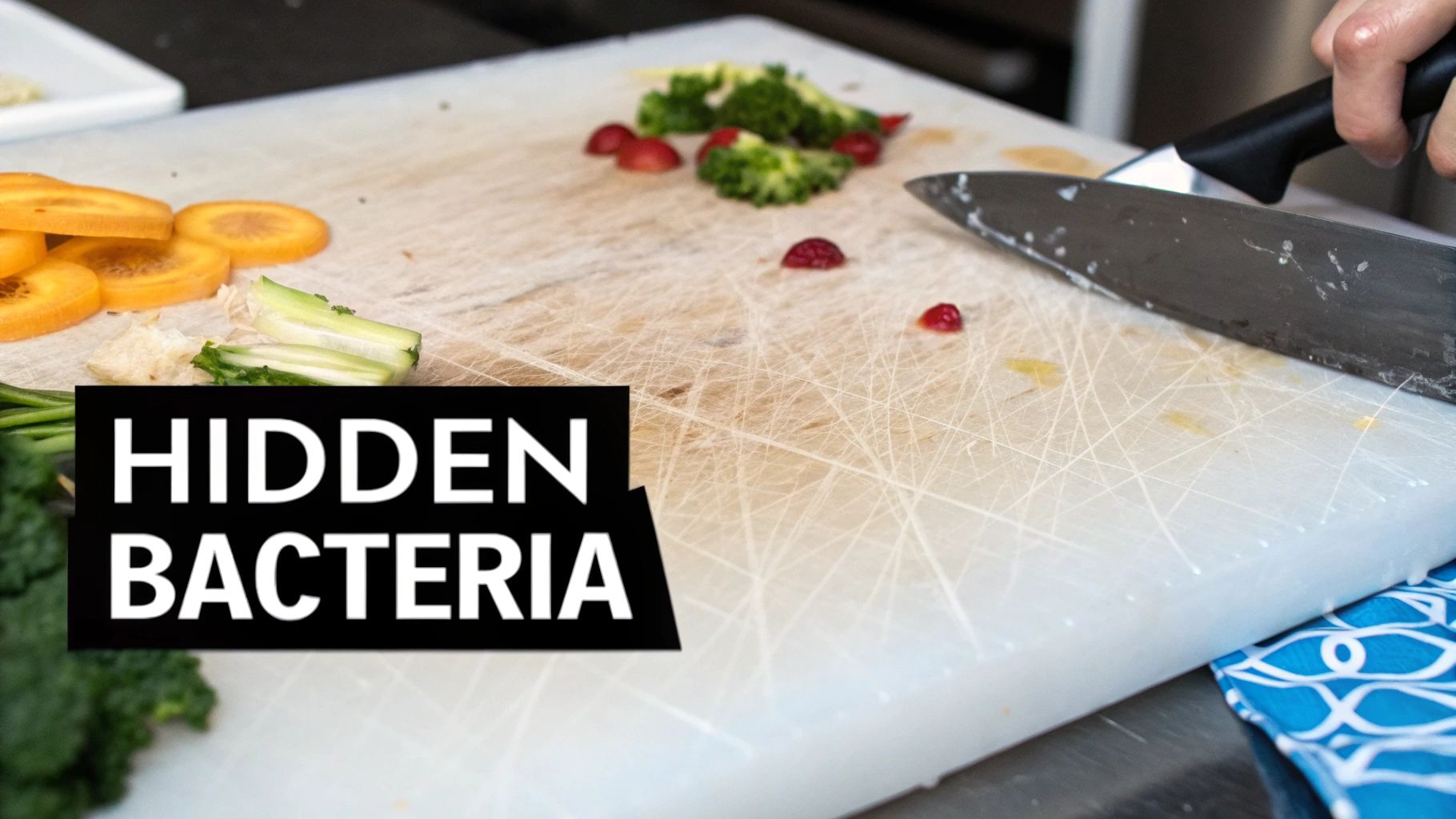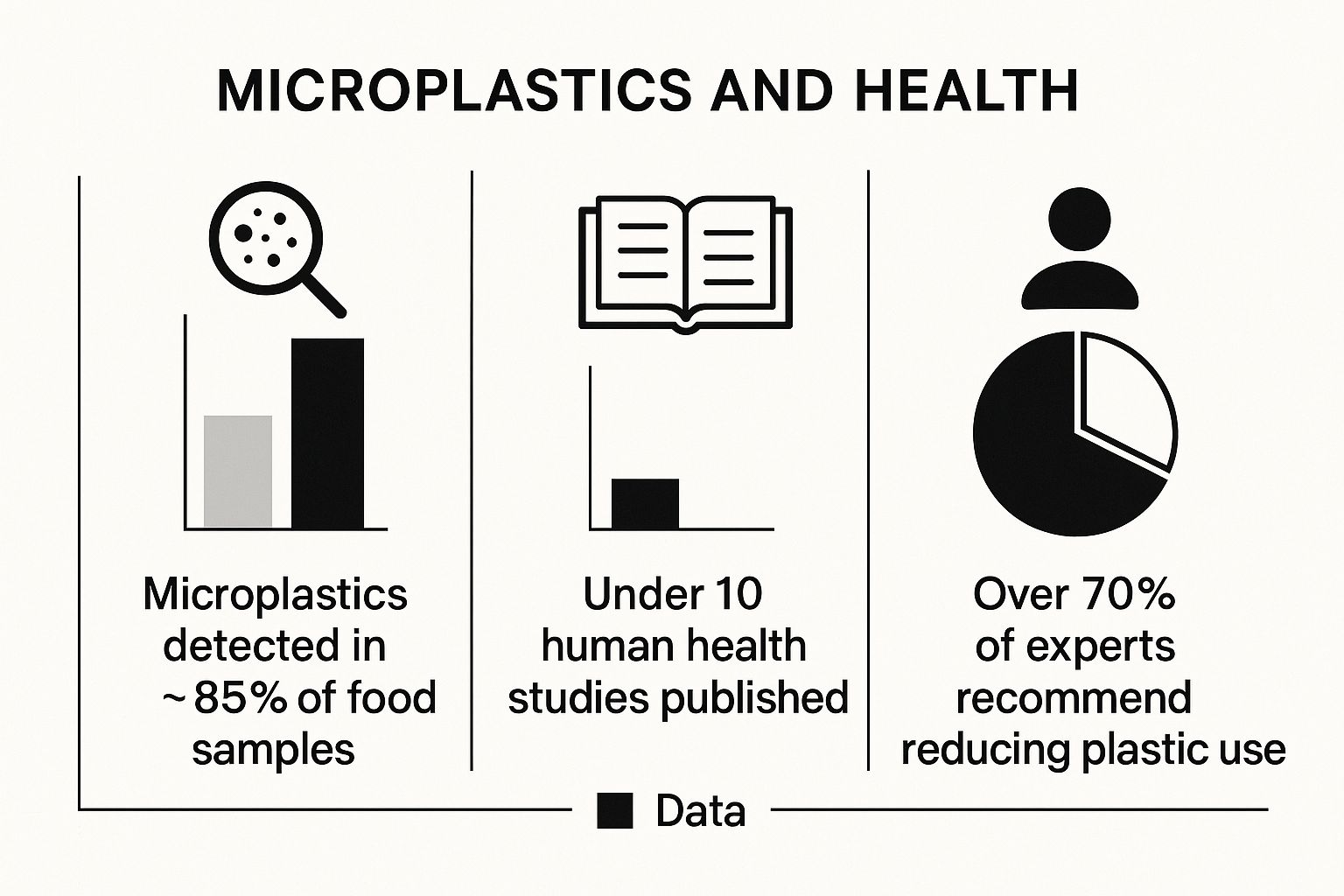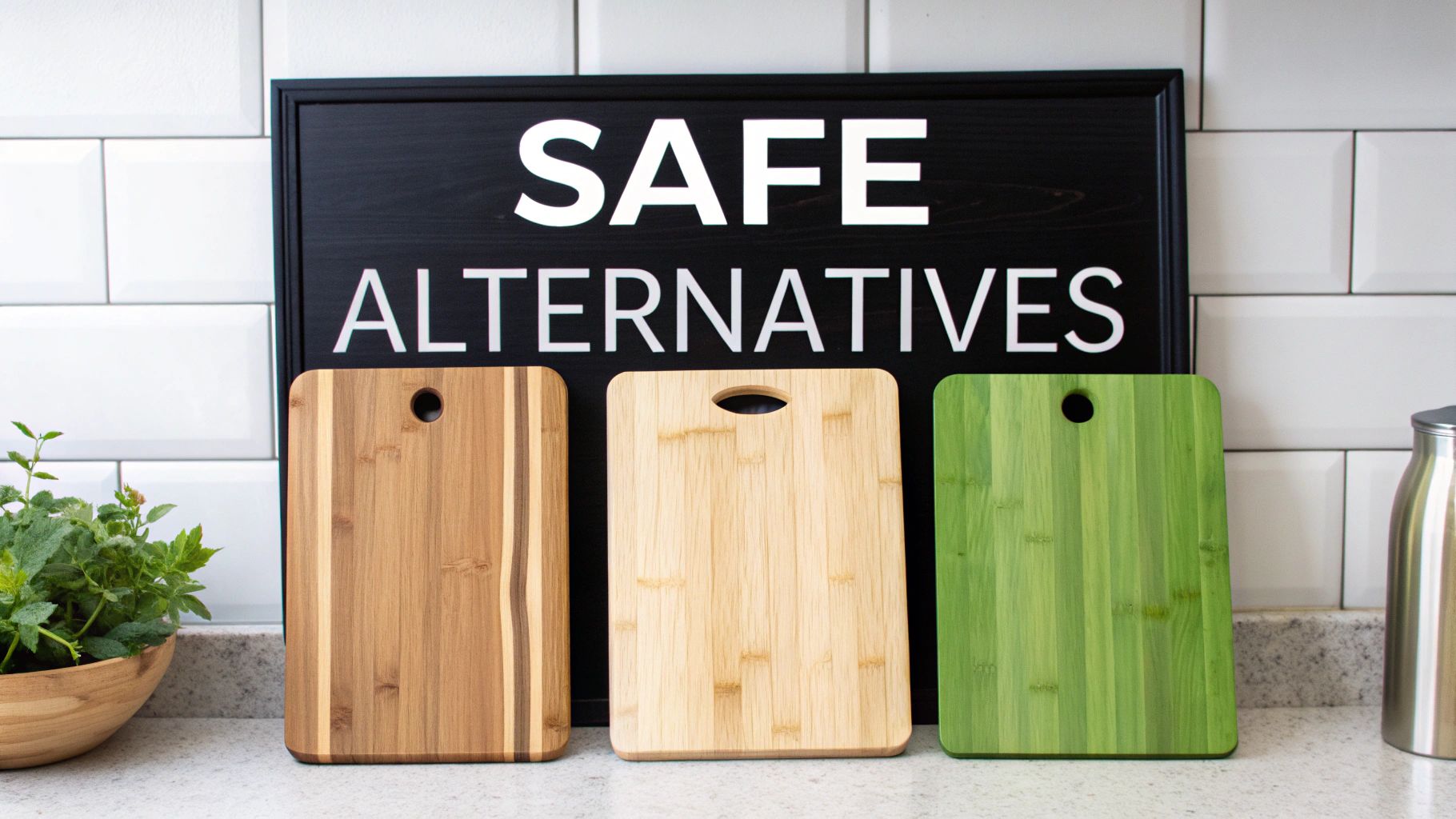Let's get right to it: are plastic cutting boards actually safe? They might be convenient, but they come with two pretty significant downsides: bacteria love to hide in the knife grooves, and tiny bits of plastic can end up in your food. Every time you chop, you’re creating microscopic nooks for germs and potentially shedding microplastics, which raises some serious health questions.
The Truth About Your Plastic Cutting Board

The humble plastic cutting board is a fixture in countless Australian kitchens. It’s light, cheap, and you can just chuck it in the dishwasher—what’s not to love? For a long time, we thought it was the most sanitary choice.
But new research is starting to flip that idea on its head, highlighting two major safety issues that are hard to ignore. The discussion is no longer just about convenience; it’s about what’s happening on a microscopic level every single time your knife hits that board.
The Two Core Safety Concerns
The real problems with plastic cutting boards aren't the kind you can see right away. They creep up over time with everyday use, creating hidden hazards that can impact your health and your food.
-
Bacterial Contamination: When it's brand new, a plastic board has a smooth, solid surface that's a breeze to clean. The problem starts with that first chop. Every slice and dice leaves behind tiny cuts and scratches that eventually become deep grooves. These crevices are the perfect place for moisture and food debris to get trapped, turning your board into a five-star hotel for nasty bacteria like Salmonella and E. coli.
-
Microplastic Shedding: That same knife action doesn't just create grooves—it also shaves off millions of microscopic plastic particles. These "microplastics" can get mixed right into the meal you're preparing, meaning you and your family could be eating them. The long-term health effects of ingesting these particles are still being studied, but it's a growing area of concern for scientists.
A heavily scarred plastic board isn't just ugly; it's a potential reservoir for bacteria and a direct source of microplastics in your diet. Even the most thorough scrubbing often can't fully sanitise the deep cuts where pathogens can hide and multiply.
Understanding these twin risks is the first step in making a smarter choice for your kitchen. You can dive deeper into these and other cutting board health risks to see why the material you choose really matters. A board’s safety isn’t just about what it’s made from, but how well it stands up to the daily grind.
To give you a clearer picture, let's break down the main safety aspects of using a plastic cutting board.
Plastic Cutting Board Safety: A Quick Glance
This table summarises the primary safety considerations for using plastic cutting boards in your kitchen.
| Safety Aspect | Potential Risk | Level of Concern |
|---|---|---|
| Hygiene Over Time | Deep knife grooves trap bacteria like Salmonella and E. coli. | High |
| Material Integrity | Daily chopping sheds microplastics directly into food. | High |
| Chemical Composition | Potential for additives (BPA, phthalates) to leach. | Medium to High |
| Heat Resistance | Can melt or warp in dishwasher, potentially releasing chemicals. | Medium |
| Cleaning Effectiveness | Surface-level cleaning is easy, but sanitising deep cuts is difficult. | High |
While a brand-new plastic board starts off as a safe and practical tool, its safety diminishes significantly with wear and tear.
The Invisible Ingredient from Your Chopping Board
Beyond the obvious scratches and bacterial hideouts, there’s a much sneakier problem with plastic chopping boards. Every time your knife cuts through an onion or a piece of chicken, it’s also scoring the board itself. And in doing so, it releases an ingredient you definitely didn't plan on adding to your meal: microplastics.
Thousands of these tiny plastic particles are shed with every chop, mixing directly into the food you're about to eat. It's a quiet, invisible process that turns a simple kitchen chore into a direct pipeline for plastic ingestion for you and your family. This isn't just a distant environmental worry; it's happening right there on your countertop.
Visualising the Plastic You Consume
The idea of eating plastic can feel a bit abstract, but when you look at the numbers, the reality hits home.
Australian research has painted a pretty sobering picture of just how much plastic we’re all taking in. A landmark 2019 study estimated that people could be consuming about five grams of plastic every single week from all sorts of sources, including particles shaved off chopping boards. To put that in perspective, that’s roughly the weight of a credit card.
More recently, a health coach drew attention to a 2023 study suggesting an individual might ingest the equivalent of 10 credit cards' worth of plastic over a year. You can get the full story on the health coach’s warning and the research at 7news.com.au.
This means that over a year, the average person could be unknowingly consuming a significant amount of plastic, with their trusty kitchen board being a key contributor.
The real worry is that these tiny particles don't just pass through our bodies harmlessly. Scientists are becoming increasingly concerned about what they could be doing to our long-term health.
From Kitchen Board to Bloodstream
Once we swallow these microplastics, they don't always stay in our digestive system. Their microscopic size allows them to go on a journey through the body, in ways we're only just beginning to understand.
Some studies have found that microplastics can get past our natural biological barriers and enter the bloodstream. Even more alarmingly, recent findings suggest they might even cross the incredibly protective blood-brain barrier just two hours after being ingested.
This opens up a whole host of serious questions about the potential health consequences, including:
- Inflammation: The presence of these foreign plastic particles could trigger inflammatory responses in our tissues.
- Cellular Damage: There are real concerns about how these particles might interact with and damage our cells.
- Chemical Leaching: Microplastics often carry chemicals from the manufacturing process, which can then be released inside our bodies.
The simple act of chopping your daily veggies suddenly becomes a lot more complicated. The invisible shedding of plastic from your chopping board is a crucial part of the kitchen safety conversation, and it highlights why the answer to "are plastic cutting boards safe?" is far from a simple yes or no.
Why Knife Scratches Are a Health Hazard

When you first unwrap a new plastic cutting board, it looks perfect. That smooth, non-porous surface seems like the very definition of a clean workspace, easy to wipe down and seemingly spotless. But that pristine state doesn't last. The very first time your knife hits the board, you start a process that creates a hidden health risk right in your kitchen.
With every chop and slice, your knife blade carves into the soft plastic. At first, they’re just tiny cuts, almost invisible. Over time, these small incisions multiply and deepen, turning that once-sleek surface into a rugged landscape of deep grooves and rough patches. These aren't just cosmetic blemishes; they're perfect hiding spots for bacteria.
From Scratches to Bacterial Havens
Picture those knife grooves as tiny canyons. When you rinse the board, water gets trapped deep inside these crevices, along with tiny particles of food—a bit of raw chicken here, some vegetable debris there. This mix of moisture and nutrients is a five-star hotel for harmful bacteria, giving them everything they need to thrive.
You might think a run through a hot dishwasher would solve the problem, but that’s not always the case. Hot water and soap often struggle to penetrate the deepest parts of the grooves, which means bacteria can easily survive the wash cycle, ready to multiply. This creates a constant risk of cross-contamination every single time you pull that board out.
A heavily scarred plastic board essentially becomes a permanent reservoir for germs. What you can't see hidden in those scratches poses a direct threat to the safety of the food you prepare on it.
This is a massive hygiene challenge for kitchens all over Australia. The deep gashes in plastic boards are notorious for making thorough cleaning almost impossible, which seriously bumps up the risk of foodborne illnesses. On top of that, this wear and tear also means you're shedding microplastics into your food, and the non-biodegradable material ends up in landfill for centuries.
The Impact on Your Knives and Kitchen Safety
Beyond the microbial threat, a heavily damaged plastic surface is also doing a number on your kitchen knives. As the board gets rougher and more uneven, it dulls your blades much faster. This not only makes your prep work a chore but can also be a safety issue, as dull knives are more likely to slip.
This accelerated wear on your knives is a consequence that many people overlook when using an old, scarred plastic board. Protecting your investment in quality knives means choosing a surface built to last. For a closer look at this, check out our guide on selecting the best knife-friendly cutting board for keeping your knives sharp.
Ultimately, a safe kitchen isn't just about your cleaning habits; it’s also about the integrity of the surfaces you use day in and day out.
What Australian Scientific Experts Say
When you start digging into whether plastic cutting boards are safe, it's easy to get lost in a sea of conflicting opinions online. The best way to cut through the noise is to look at what the scientific experts are actually saying. Here in Australia, top organisations are deep into this research, giving us a clear, fact-based view. The goal isn't to create alarm, but to understand what the science tells us right now.
The biggest talking point is, of course, microplastics. We know they're ending up in our food, that part is clear. The real question scientists are trying to answer is what happens once they get inside our bodies.
The CSIRO Position on Microplastics
As Australia’s national science agency, the Commonwealth Scientific and Industrial Research Organisation (CSIRO), is a voice we can trust. Their research confirms that while we are finding more and more evidence of microplastics in our food and water, there isn't yet a conclusive study that proves they directly harm human health.
The CSIRO points out that we urgently need more research to understand what a "normal" level of exposure looks like and, crucially, to figure out the point at which these particles become toxic. In simple terms, we don't know how much is too much. While the jury is still out, they suggest a sensible approach called the "precautionary principle." You can dive deeper and read CSIRO's full analysis on food safety on their website.
The precautionary principle is just common sense, really. It means that if there’s a suspected risk of harm—even without 100% scientific proof—it’s smart to take steps to protect yourself. This is exactly why many experts are now recommending we reduce our use of plastics in the kitchen.
This infographic really puts the current situation into perspective, showing the big gap between how often we find microplastics and how little we still know about their impact on our health.

As you can see, the contamination is widespread, but the solid health research is still playing catch-up. This is why the experts are advising caution. By staying informed with this kind of expert guidance, you can make smarter choices for a safer kitchen while the science continues to unfold.
Safer and More Sustainable Alternatives

If you're starting to second-guess your plastic cutting board after learning about microplastics and bacteria, you're not the only one. The good news is, there are plenty of fantastic alternatives out there.
Making the switch isn't just about dodging health risks. It's an opportunity to bring a more durable, beautiful, and often more enjoyable tool into your kitchen. From traditional wood to modern metals, let's explore your options.
The Classic Choice: Wooden Cutting Boards
There’s a reason chefs have sworn by wood for generations. It’s the original, and many would say, the best.
Hardwoods like maple, walnut, and cherry are tough enough to last for years but have enough "give" to be gentle on your knife edges. Unlike plastic that gets permanently scarred with every chop, wood fibres have this incredible ability to partially self-heal, swelling back to close minor cuts.
This isn’t just about looks, either. This "self-healing" feature means fewer deep crevices for bacteria to hide and thrive in.
Interestingly, wood has a natural defence mechanism. Studies have shown that wood's porous grain can pull bacteria down into its fibres via capillary action. Once trapped deep inside, away from moisture and nutrients, the bacteria simply die off.
Of course, a good wooden board needs a little TLC. It’s a hand-wash-only item and needs a regular rub-down with food-safe mineral oil to keep it from drying out and cracking.
The Sustainable Option: Bamboo Cutting Boards
Technically a grass, not a wood, bamboo has carved out a name for itself as a stellar kitchen material. It’s a champion of sustainability, growing incredibly fast and requiring far fewer resources than traditional hardwoods.
Bamboo is also denser and less porous than most woods. This gives it fantastic resistance to knife scarring and means it won't soak up liquids (or germs) as easily. It’s a solid, low-maintenance choice for any busy kitchen.
Here’s a quick rundown of what makes bamboo a great pick:
- Eco-Friendly: A fast-growing, highly renewable resource.
- Durable: Its dense surface stands up well to deep scratches.
- Low Maintenance: Being less porous than wood, it's easier to keep clean and hygienic.
The only real trade-off is its hardness. That same density that makes it so durable can be a bit tough on your knives, causing them to dull a little faster than they would on a softer wood.
Other Notable Materials
While wood and bamboo are the front-runners, a few other materials bring their own unique advantages to the chopping block.
Glass Cutting Boards: On the plus side, glass is completely non-porous. You can scrub it, bleach it, or toss it in the dishwasher, and it will come out perfectly sanitised every time. The massive drawback? It's murder on your knives. The unforgiving surface will dull a sharp blade almost instantly.
Titanium Cutting Boards: A premium, modern option that’s gaining traction. Titanium is non-porous, lightweight, will never rust, and is completely non-toxic. It provides an exceptionally hygienic surface without any worries about shedding microplastics. To dig deeper, you can explore the benefits and drawbacks of titanium cutting boards and decide if it's the right fit for you.
To make things a bit clearer, let's break down how these materials stack up against each other.
Comparing Your Cutting Board Options
This table offers a side-by-side look at the most popular cutting board materials to help you find the best and safest option for your kitchen.
| Material | Key Benefits | Main Drawbacks | Best For |
|---|---|---|---|
| Wood | Knife-friendly, self-healing fibres, naturally antimicrobial. | Requires regular oiling and hand-washing. | Everyday cooking, protecting high-quality knives. |
| Bamboo | Eco-friendly, durable, water-resistant, low maintenance. | Can be hard on knife edges, dulling them faster. | Eco-conscious cooks who want a durable, easy-care surface. |
| Glass | Extremely hygienic, non-porous, dishwasher safe. | Very hard on knives, noisy to cut on. | Situations where absolute sanitation is the top priority. |
| Titanium | Completely non-toxic, non-porous, won't dull knives, rust-proof. | Premium price point. | Health-conscious cooks looking for a lifetime investment. |
By choosing a better alternative, you can stop worrying about whether your plastic cutting boards are safe and just get back to enjoying your time in the kitchen.
Your Cutting Board Safety Questions Answered
When it comes to kitchen safety, it's the everyday tools we often overlook. You've got questions about your cutting boards, and you need real, practical answers. Let's clear up the confusion so you can feel confident about what's happening on your countertop.
We'll tackle the big ones—from whether you can salvage that old plastic board to if wood is really okay for raw meat.
Can I Still Use My Plastic Board Safely?
Look, if you're stuck with a plastic board for now, your best defence is a rigorous cleaning routine. The second you're done with it, especially after dicing chicken or handling any raw meat, it needs a serious scrub with hot, soapy water.
To take it a step further, you can sanitise it. Just mix one tablespoon of unscented liquid chlorine bleach into about four litres of water. Let that solution sit on the board for a few minutes to get to work on any nasty bacteria, then give it a final, thorough rinse and let it air-dry properly.
Keep in mind, this is really just a stopgap measure. No amount of bleach can penetrate the deep scratches and knife scars on a well-used board where bacteria love to hide. This process lowers the risk, but it definitely doesn't eliminate it.
This cleaning drill is a good habit, but it’s more important to recognise when a board is simply past its prime and has become a health hazard.
How Often Should I Replace a Plastic Board?
There’s no hard-and-fast rule here. A plastic board doesn't come with an expiry date—its lifespan really comes down to how much action it sees. The key is to keep an eye on its condition.
Give it a quick inspection. Run your fingers over the surface. Can you feel deep gouges and a rough, fuzzy texture? If your fingernail gets caught in the grooves, that's your sign. The board has become so scarred that it's impossible to clean properly. At this stage, it's not just a breeding ground for germs; it's also shedding microplastics into your food. Once it looks and feels like a miniature battlefield, it's time for it to go.
Is It Safe to Use Wooden Boards for Raw Meat?
Absolutely. You can safely prep raw meat on a wooden board, as long as you're smart about it. In fact, many hardwoods have natural antimicrobial properties that give them an edge over plastic by actively fighting off bacteria.
The golden rule is avoiding cross-contamination. Here’s how you do it:
- Dedicate a Board: The best practice is to assign one wooden board for raw meat, poultry, and fish only. Keep another one completely separate for your veggies, fruits, and bread.
- Clean Immediately: Don’t let it sit. The moment you’re done, wash it with hot water and soap.
- Rinse and Dry: Rinse it well and, most importantly, let it air-dry completely. Bacteria thrive in moisture, so a dry board is a safe board.
Are BPA-Free Plastic Boards a Safer Option?
Seeing "BPA-free" on the label can feel reassuring, and while it means you're dodging one particular chemical, it doesn't solve the main problems with plastic cutting boards.
Think about it: a BPA-free board still gets sliced up by your knives. It will still develop those same grooves where bacteria can set up camp, and it will still shed microplastics with every chop. The fundamental issue is the physical nature of plastic breaking down, and being BPA-free doesn't change that reality. So, from a hygiene and microplastic standpoint, it's not the safer solution you might think it is.
Ready for a cutting board that eliminates the worries of bacteria and microplastics for good? The Everti Titanium Cutting Board offers a pure, non-porous, and non-toxic surface that’s gentle on your knives and built to last a lifetime. Make the switch to a safer, cleaner kitchen by exploring our collection.
Article created using Outrank

